Springtime is hummingbird time in Texas! From mid-March to early May, hummingbirds come flourishing in! Did you know Texas has 18 hummingbird species, making this state one of the best places to witness the hummingbird’s beauty?
In spring, you can see around ten seasonal species of hummingbird. If you are lucky, you’ll see an additional eight species that have been rarely spotted in the state. Take the time to learn about each species, and hopefully, by the end, you will be able to spot these magnificent little creatures.
Seasonal Species Of Hummingbirds In Texas
Ruby-throated Hummingbird

- Scientific Name: Archilochus colubris
- Length: 2.8 to 3.5 inches
- Weight: 0.071 to 0.212 ounces
- Wingspan: 3.1 to 4.3 inches
The male has a shimmering ruby-red throat with a white collar, a forked tail that appears black with a hint of violet, and a green head. The male backside is emerald green.
The female Ruby-throated hummingbird has a notched tail, and the outer feathers are green, black, and white. Her back is emerald green, and she has a white throat that can appear plain or have stipples or streaks.
This beautiful bird is one of the most common hummingbirds that pass through Texas during their spring migration. They breed in pine forests, orchards, and forest edges. The Ruby-throated hummingbird is a migratory hummingbird. During winter, this bird will stay in Central America, Florida as well as southern Mexico.
Black-chinned Hummingbird
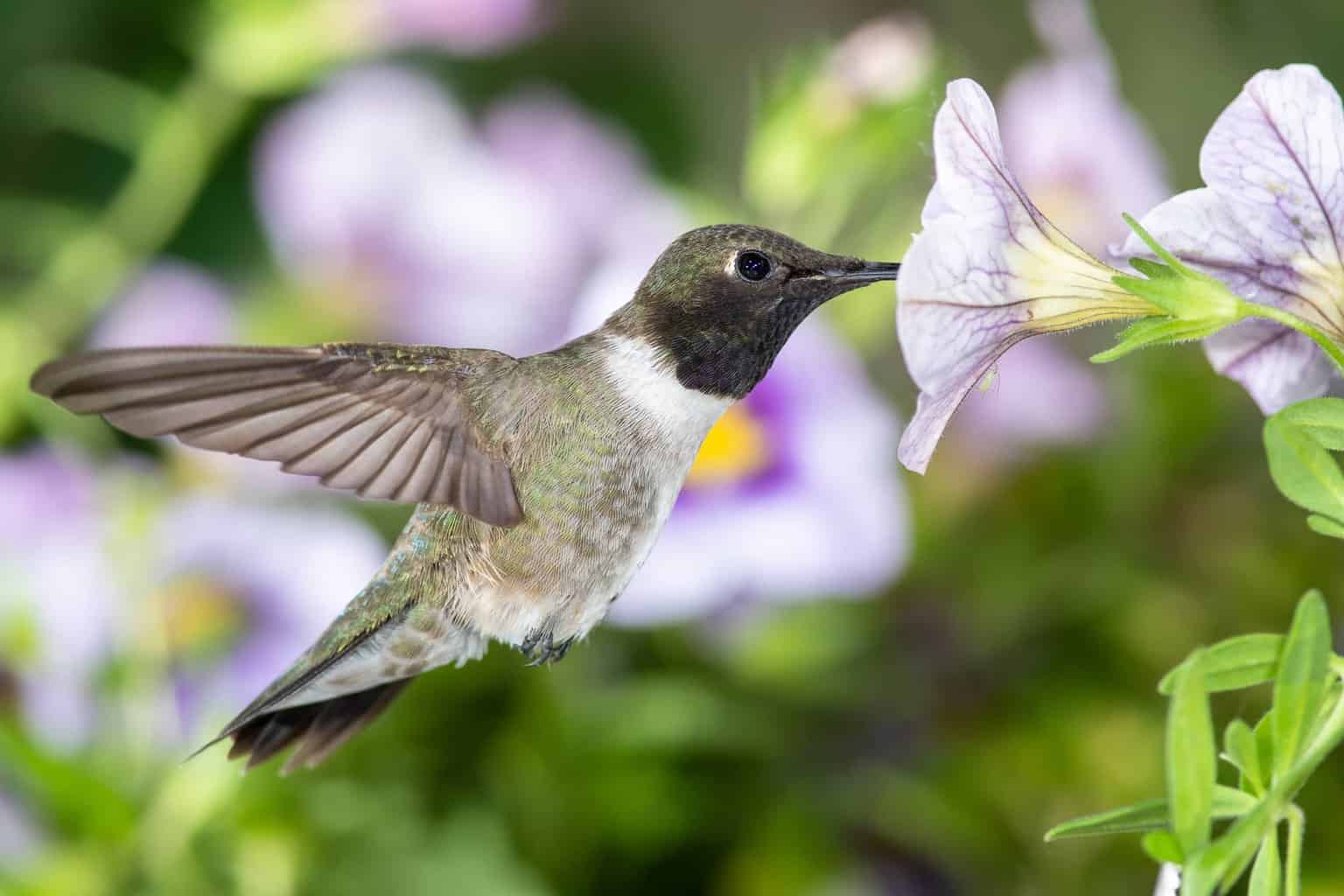
- Scientific Name: Archilochus alexandri
- Length: 3.25 inches
- Weight: 0.1 to 0.2 ounces
- Wingspan: 4.3 inches
The adult male Black-chinned hummingbird has a metallic green back, a black face, and a black chin. He has a dark forked tail and an iridescent purple color just below the black throat.
The female has a metallic green back. However, her throat has a white appearance with green streaks. The corners of her tail are coated in white tips.
This hummingbird is commonly found in central and west Texas during the summer months. They enjoy open breeding habitats such as meadows and orchards. When it starts to get chilly, the Black-chinned hummingbird will migrate. They are known to spend winter in Mexico.
Buff-bellied Hummingbird

- Scientific Name: Amazilia yucatanensis
- Length: 3.9 to 4.3 inches
- Weight: 0.14 to 0.18 ounces
- Wingspan: 6 inches
The male and female Buff-bellied hummingbirds are very similar in appearance! Male and female adults have an iridescent olive green upper side. Their tail is rufous in color, and they have a noticeably bright red slender bill.
The only difference is that the female is less colorful than the male and has a dark upper bill.
Buff-bellied hummingbirds are found in southern Texas. They breed in forests and thickets.
The buff-bellied hummingbird is partially migratory. Only a small portion of these hummingbirds will winter along the Gulf Coast of the United States.
Rufous Hummingbird

- Scientific Name: Selasphorus rufus
- Length: 3.1 inches
- Weight: 0.071 to 0.176 ounces
- Wingspan: 4.3 inches
Overall, the male is a bright orange, with an orange back and a beautiful reddish-orange iridescent throat. In some instances, the males have been found with a green tint on their back and or crown.
The female hummingbird is quite a bit bigger than the male and has a green upper side.
These birds enjoy open breeding habitats such as forest edges or mountainsides. Although this bird is becoming increasingly hard to find in Texas, if found, it is usually in west Texas.
These very aggressive birds are highly territorial and will fight larger birds for food.
During winter, the Rufous hummingbird will travel over 2000 miles to reach its winter destination. They winter in the Mexican state of Guerrero.
Broad-tailed Hummingbird

- Scientific Name: Selasphorus platycercus
- Length: 4 inches
- Weight: 0.13 ounces
- Wingspan: 5.25 inches
The male Broad-tailed hummingbird has a bright green back and rose-red throat. It is often identified by the white ring around its eye.
The females are a lot paler than the males, and their flanks are cinnamon in color. The cheek of the female has green spots, which the male doesn’t have.
The number of these hummingbirds is known to peak between early August and October. They breed in juniper scrub as well as pine-oak woodlands of upper Texas.
The Broad-tailed hummingbird only demonstrates partial migration. The groups that migrate spend winter in Guatemala and southern Mexico.
Anna’s Hummingbird

- Scientific Name: Calypte anna
- Length: 3.9 to 4.3 inches
- Weight: 0.1 to 0.2 ounces
- Wingspan: 4.7 inches
The male has an iridescent green-bronze back, a chest and belly that are a pale gray color, and green flanks. They have a forked tail with a crimson-red gorget and crown!
The females are similar to the males, except they are smaller and have round, white-tipped tails. They have a dull green crown, and their gray throat can have bits of iridescent red.
These birds breed in shrubby or open wooded habitats. They are found in parts of western Texas.
A large majority of Anna’s hummingbirds don’t migrate for winter and spend the entire year in the Pacific Northwest. These hummingbirds have acclimatized to colder temperatures and rely on nectar feeders in winter.
Lucifer Hummingbird
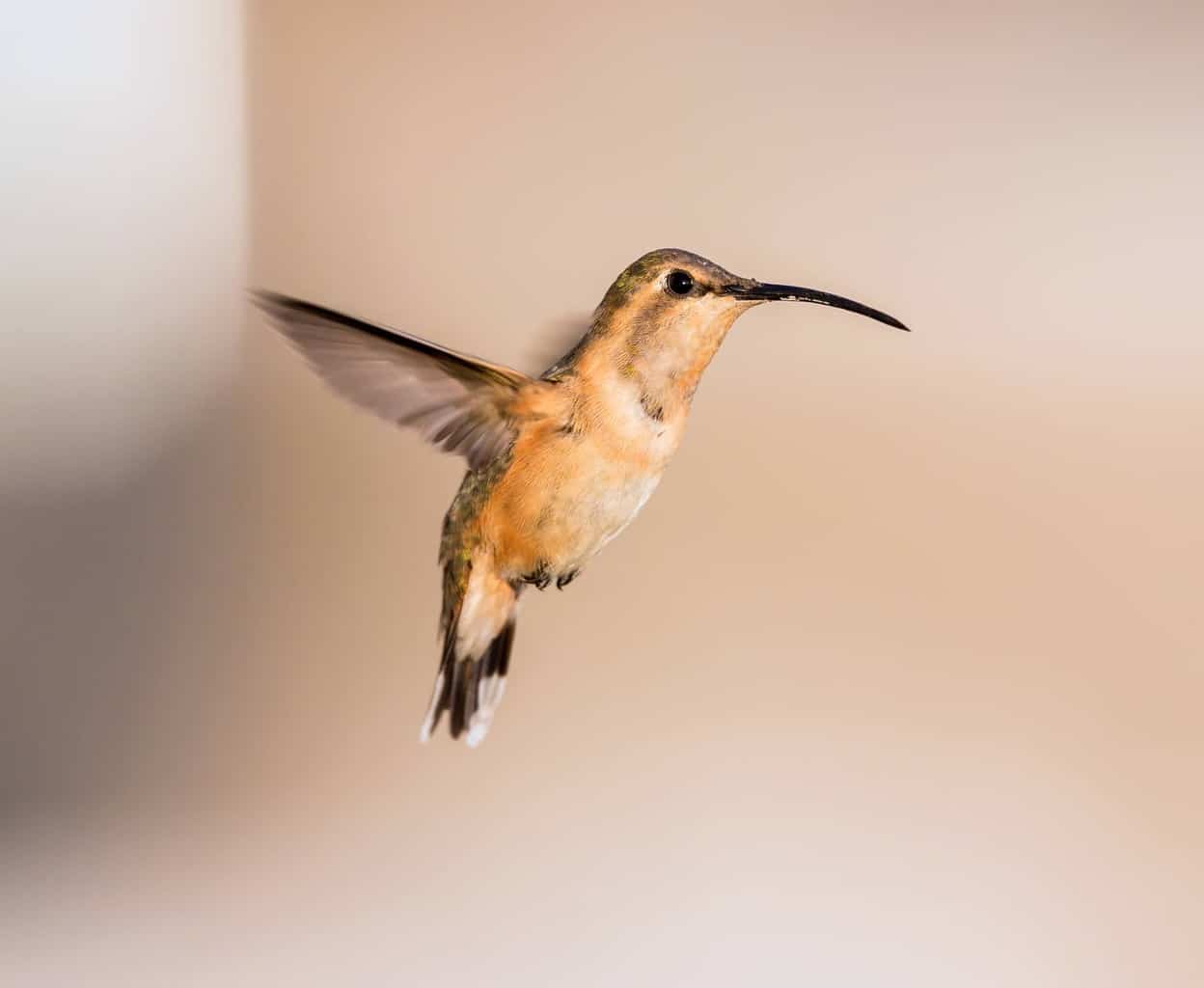
- Scientific Name: Calothorax Lucifer
- Length: 3.9 inches
- Weight: 0.1 ounce
- Wingspan: 4 inches
The male Lucifer hummingbird has a green upper side, a dark forked tail, and a white breast. Their most eye-catching feature is their iridescent purple throat.
The female is a lot duller and has a warm buff belly. They also have a green upper side.
Males and females have an identifiable white streak behind their eyes!
These hummingbirds can be found in southern Texas, breeding in deserts or arid areas with agave plants.
The Lucifer Hummingbird is migratory. These birds will commonly winter in central Mexico.
Calliope Hummingbird

- Scientific Name: Selasphorus calliope
- Length: 2.8 to 3.9 inches
- Weight: 0.071 to 0.106 ounces
- Wingspan: 4.3 inches
The male has a glimmering green crown and back, a green flank, and the underside appears white. Their gorget has red streaks, and their tail is dark.
The females have dark streaks on their gorget, and their dark tail has white tips. Furthermore, their flank has a brush of pink.
This hummingbird is found in west Texas in El Paso and Big Bend National Park. They often breed in higher altitudes such as mountains with shrub habitats. The Calliope hummingbird has a wide range of wintering grounds. These birds migrate to Central America, Mexico, and the southwest United States during wintertime.
Blue Throated Hummingbird
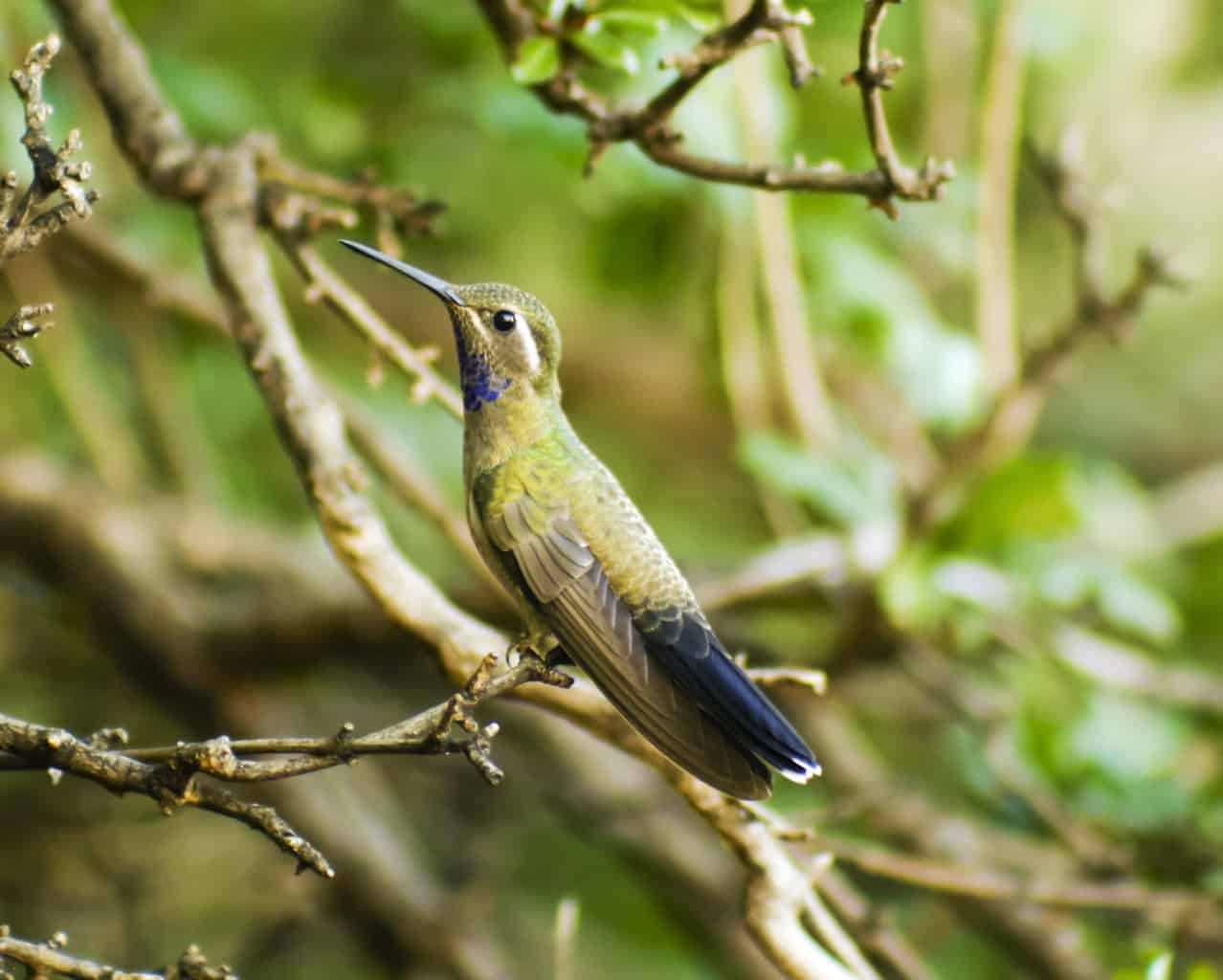
- Scientific Name: Lampornis clemenciae
- Length: 4.5 to 4.9 inches
- Weight: 0.21 to 0.35 ounces
- Wingspan: 2.3 to 3.1 inches
Also called the Blue-throated Mountain Gem, the male and female look quite similar. The main difference between them is that the males have an iridescent blue throat, whereas the female throat is gray. Both males and females have a dull green upper side and gray belly. Behind their eye is a white stripe.
Additionally, both have a narrow white strip that borders their dark cheek extending to their bill, and they have white tips on their black tail feathers.
These beautiful blues can be found in the western parts of Texas and breed in moist wooded canyons.
This hummingbird doesn’t commonly migrate from Mexico, where they are a permanent resident. However, a few of them are known to migrate to southwest Arizona in winter.
Magnificent/ Rivoli’s Hummingbird
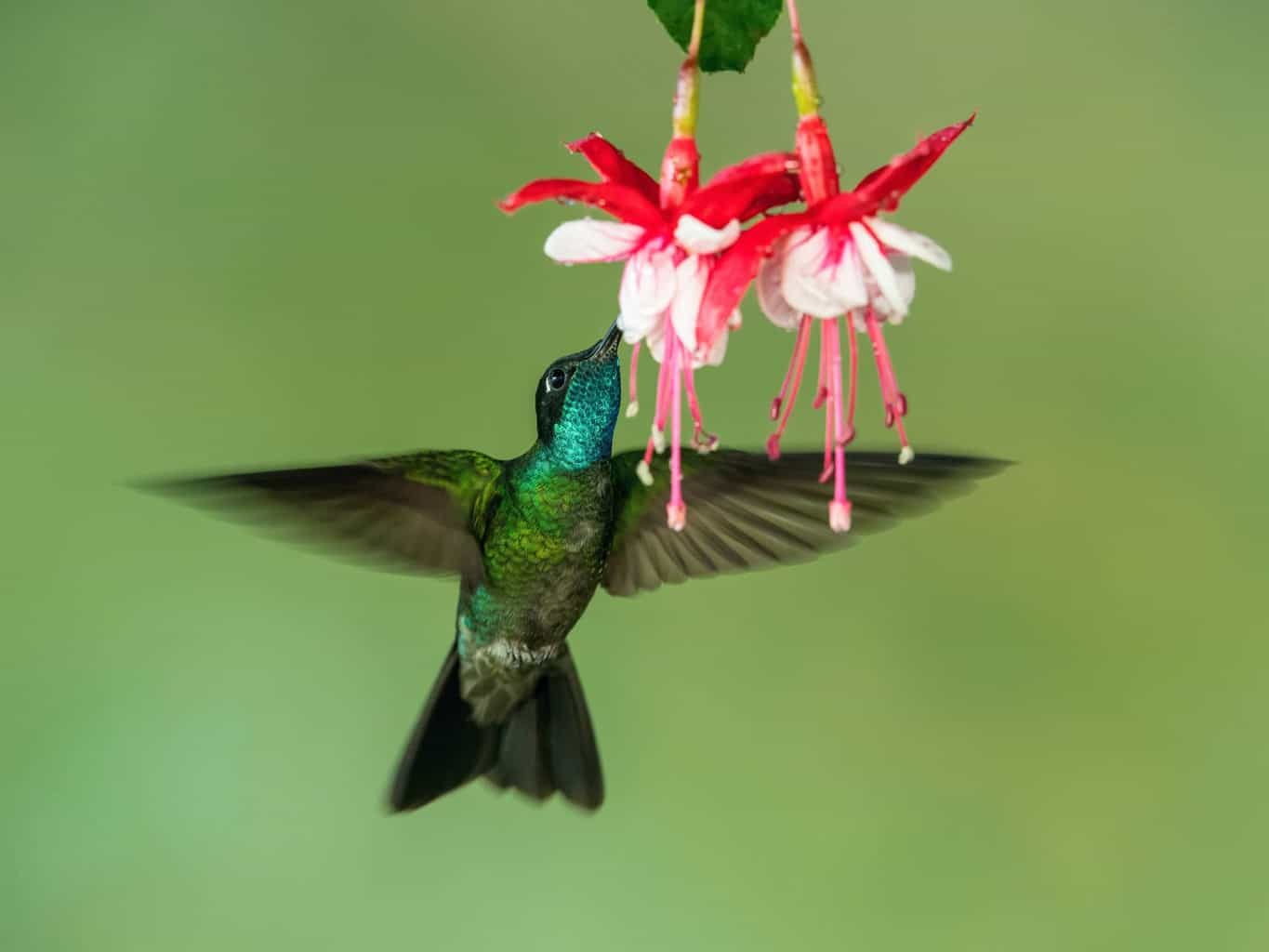
- Scientific Name: Eugenes fulgens
- Length: 4.3 to 5.5 inches
- Weight: 0.21 to 0.35 ounces
- Wingspan: 7.1 inches
The male has a green-bronze backside which fades into a bronze closer to the black-tipped tail. They have a blue-green gorget, purple crown, and a white spot behind their eyes.
The female has a bronze-green backside with a dull green underside. Unlike the male (who has a white dot), behind her eye is a white stripe.
These magnificent birds are spotted in western Texas and often breed in pine-fir-juniper-oak forests.
The magnificent hummingbird does migrate during winter, depending on its summer and spring location. Those who were in Mexico will move further south, and those in the United States will move to southern Mexico.
Rare/Accidental Hummingbird Species In Texas
Allen’s Hummingbird
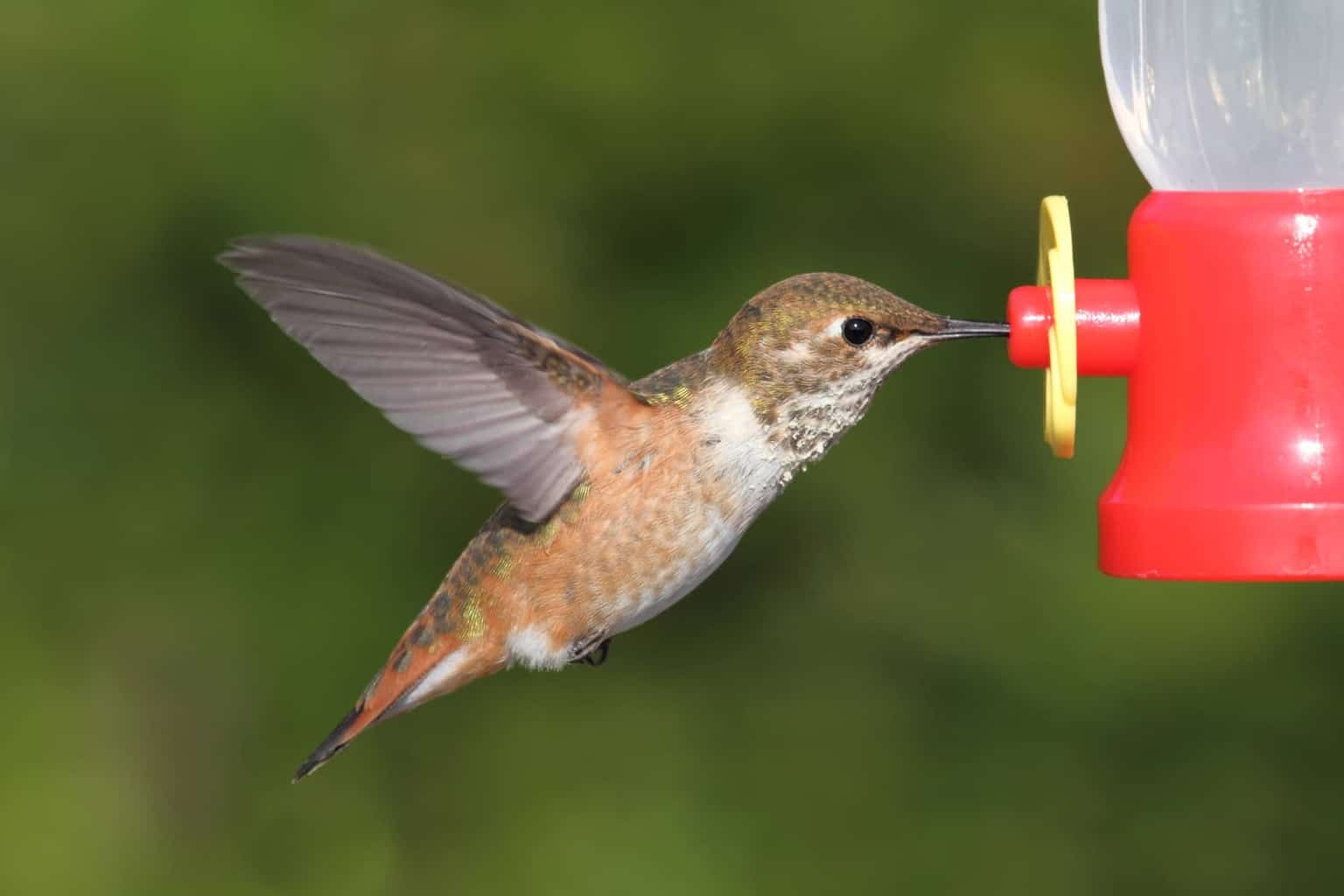
- Scientific Name: Selasphorus sasin
- Length: 3 to 3.5 inches
- Weight: 0.1 ounce
- Wingspan: 4.3 inches
The male has rufous flanks, tail, rump, and a green backside and forehead. The iridescent orange-red throat and eye patch are quite a sight!
The females look very similar, except they lack the striking orange-red throat. Only their white-tipped narrow outer tail feathers are green and rufous.
The Allen’s hummingbird is rare but can occasionally be found in west and south Texas. Its preferred breeding ground is along the coast of California in shaded woods, occasional gardens, and meadows.
In winter, Allen’s hummingbird will move to south-central Mexico.
Broad-billed Hummingbird

- Scientific Name: Cynanthus Latirostris
- Length: 3.1 to 3.9 inches
- Weight: 0.1 to 0.14 ounces
- Wingspan: 5.1 inches
The male is dark green and has white undertail coverts. He has a blue throat and a tail that is a mixture of black and blue.
The female has a white stripe behind her eye and a pale gray belly. She also has a white-tipped tail.
This hummingbird has been spotted in southern Texas. However, it commonly breeds in southeast Arizona and southwest New Mexico. This hummingbird prefers breeding in desert canyons and oak woodlands low on the mountains.
The Broad-billed hummingbird has a complex migratory path. This hummingbird is widespread, but those who reside in Mexico will stay all year round whereas others will rarely spend winter in southern California, Texas, Oregon, and the East Coast.
Mexican Violetear Hummingbird
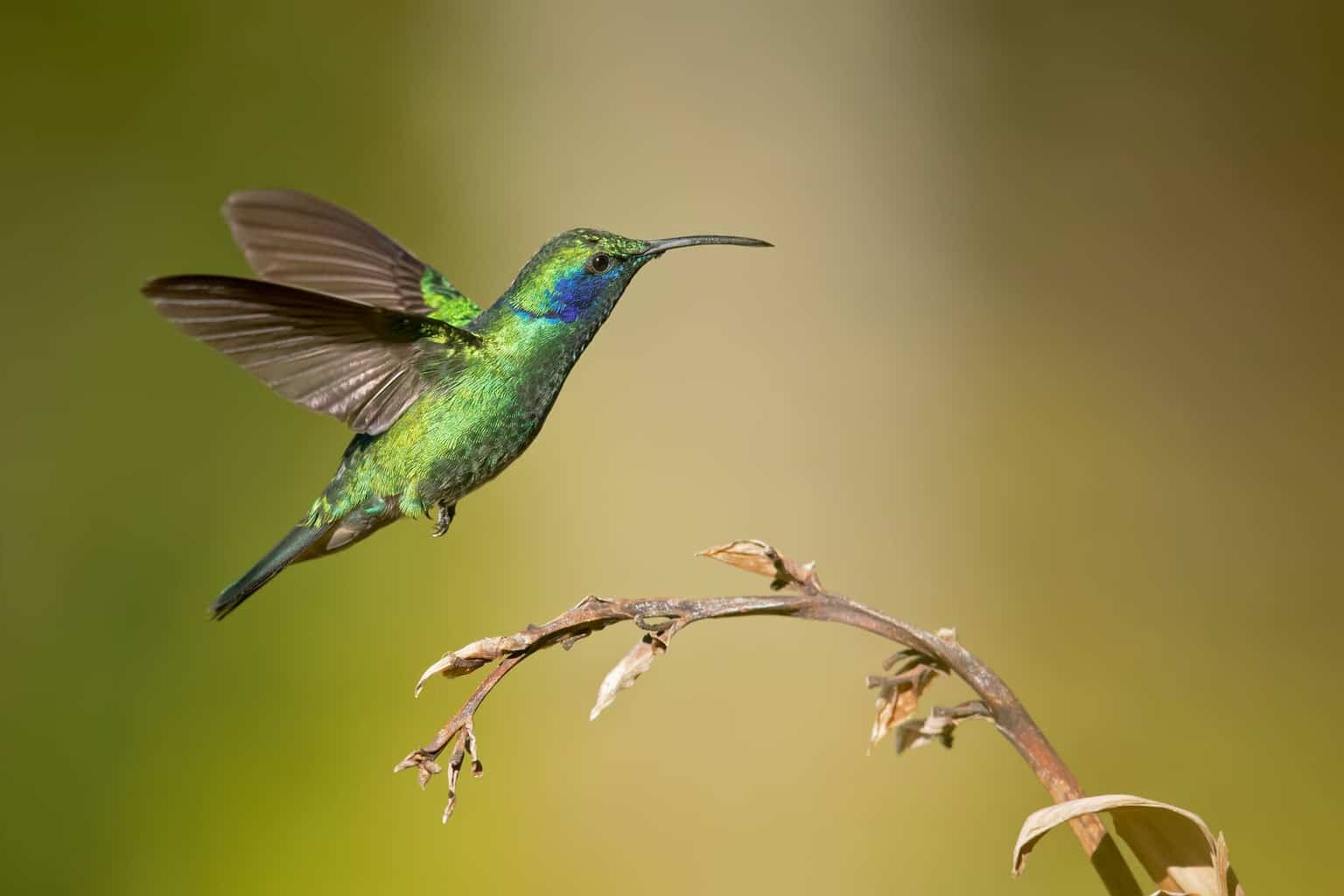
- Scientific Name: Colibri thalassinus
- Length: 3.8 to 4.57 inches
- Weight: 0.17 to 0.20 ounces
- Wingspan: 4.7 inches
The male and female Mexican Violetear are very similar. The only difference is that the female is smaller, and the violet chin band is thinner. Overall, both have a shining green upper side, throat, and chest with a violet ear patch on their neck.
This medium-sized hummingbird has a metallic green tail with hints of blue intertwined, and the center of the tail has bronze feathers.
Although this is a rare sighting in Texas, it can be found in southern or central Texas. Its preferred breeding ground is the highlands of southern Mexico.
The migration pattern of the Mexican Violetear is complex and not adequately understood. Many hummingbirds who were farther north will head south in winter, but exactly where is unknown.
Violet Crowned Hummingbird
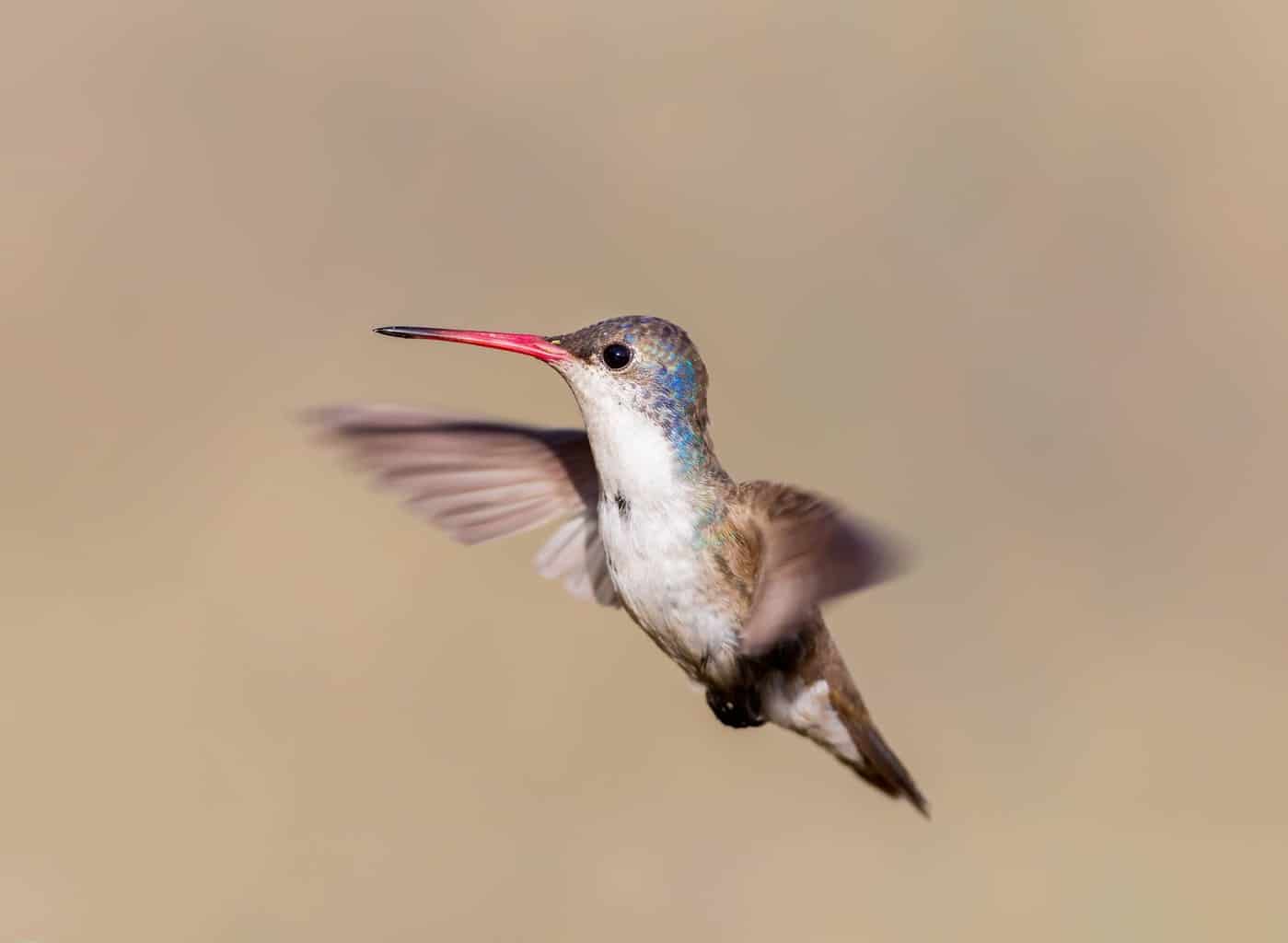
- Scientific Name: Leucolio violiceps
- Length: 3.93 inches
- Weight: 0.18 ounce
- Wingspan: 5.5 inches
The male and female Violet Crowned hummingbirds are very similar in appearance, but the female coloring is duller, especially the coloring of the crown. Overall, both have a dark olive-green upper side, whereas the underneath is primarily white. They have a violet crown on their head and a straight slim red bill with a black tip.
This hummingbird typically breeds in the arid scrub of Arizona and southwest Mexico. However, occasionally it is found in the southwest parts of Texas.
The Violet-crowned hummingbird is partially migratory. They will move south from their northern locations during wintertime, but some will stay behind.
White-eared Hummingbird
- Scientific Name: Basilinna leucotis
- Length: 3.54 to 3.94 inches
- Weight: 0.11 to 0.14 ounces
- Wingspan: 4 to 5 inches
White-eared hummingbirds have a white eye stripe, green breast and upper side, with white underneath. They have a bronze-colored straight tail with hints of green.
Males have a straight short, slim red bill tipped with black, a turquoise green throat, and black head.
The female’s bill is black and has some orange at the base. Females are less colorful and have a pale-cream colored throat with turquoise green speckles.
Although rare, they sometimes can be found in western Texas. However, their ideal breeding habitat is pine-oak forests in Arizona and Mexico.
The White-eared hummingbird is a migratory hummingbird. They will leave their summer locations and head to Mexico for winter by October.
Costa’s Hummingbird

- Scientific Name: Calypte costae
- Length: 3 to 3.5 inches
- Weight: 0.107 to 0.113 ounces
- Wingspan: 4.3 inches
Male and female Costa’s hummingbirds look quite similar! The males’ back and flank are a noticeable green, whereas the female’s green coloring appears grayer. The female also has a white underbelly, unlike the male.
The male has a small black tail and wings, and its gorget and crown are iridescent purple. Patches of white can be seen below the purple gorget, throat, and tail.
This hummingbird is rarely found in west Texas. Ideally, they breed in the arid regions of the southwest United States and northwest Mexico. The Costa’s hummingbird migrates for winter to western Mexico.
Green-breasted Mango Hummingbird

- Scientific Name: Anthracothorax prevostil
- Length: 4.33 to 4.72 inches
- Weight: 0.24 to 0.25 ounces
- Wingspan: 5 to 6 inches
The male and female both have black feathers in the center of their tail.
The male’s tail has dark magenta outer feathers with black tips and a bright green back and flank. His throat and chest are matte black in the center with a blue-green border.
The females have magenta outer feathers and a glossy dark blue tail with white tips on the last three or four feathers. They have white underparts and bronze-green upper sides.
These birds are uncommon in Texas but are becoming increasing vagrants in the Rio Grande Valley of southern Texas. Their ideal breeding habitat is tropical forests, gardens, and orchards in eastern and central Mexico and Central America.
This hummingbird is partially migratory. The exact location where this hummingbird winters is unknown.
Berylline Hummingbird
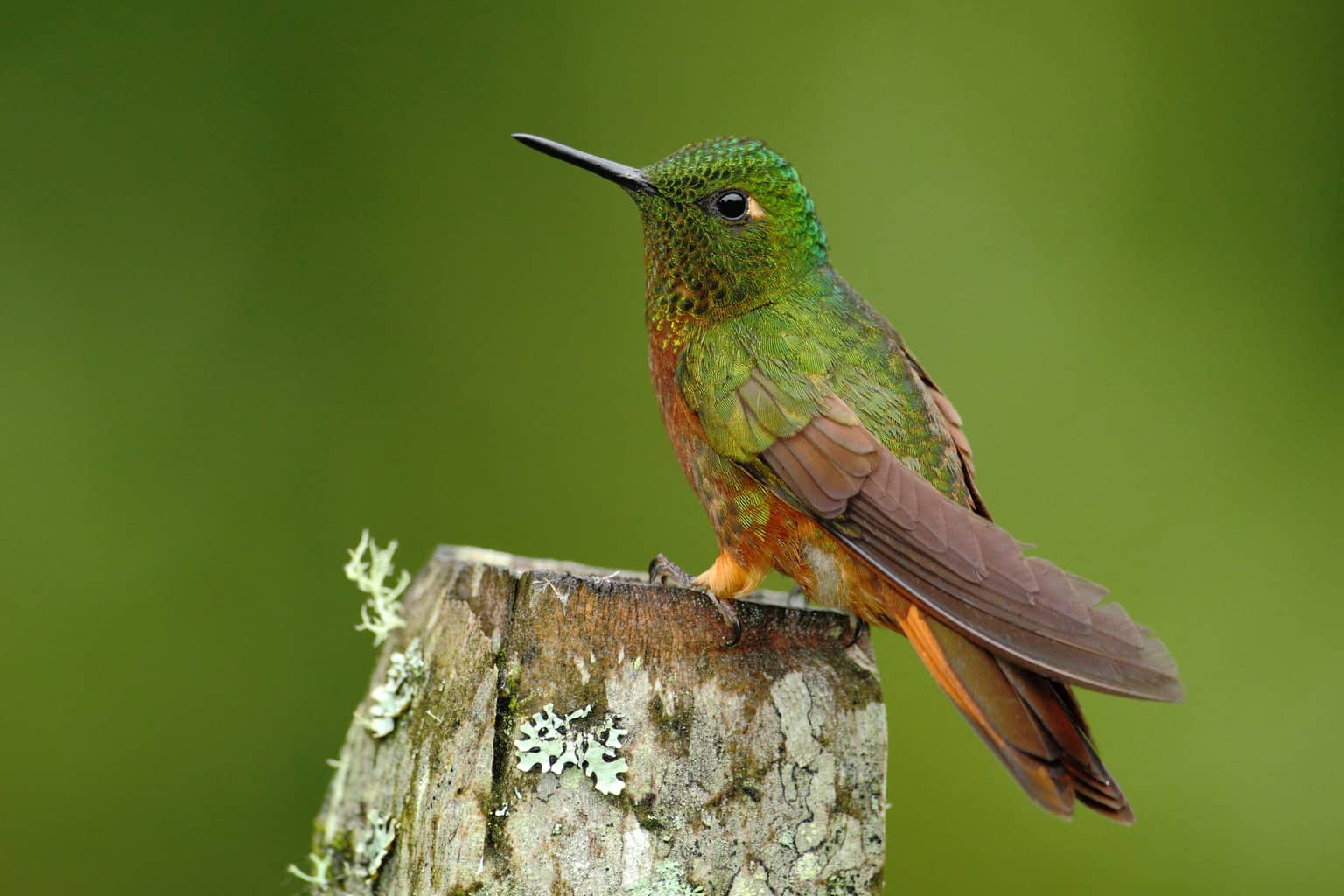
- Scientific Name: Saucerottia berylline
- Length: 3.15 to 3.83 inches
- Weight: 0.14 to 0.18 ounces
- Wingspan: 5.25 inches
This hummingbird has two very similar looking sexes. The female is less colorful, and her belly has less buff coloring than the male. Overall, their general coloring is metallic olive green. They have a forked rufous tail, and their lower belly is rusty gray. They have rufous coloring on their primary and underwings.
The males’ slim bill is straight and has a dark red color which is almost black.
This hummingbird breeds in forests and thickets in Mexico and Central America. It has also been rarely spotted in various mountainous regions around Texas. The Berylline Hummingbird is mostly non-migratory. It does not leave its summer location for winter.
Conclusion
Now that you know how to identify 18 types of hummingbirds, head on down to Texas and see some of the most exquisite birds around.
If you’re also curious about other birds you might see during your stay there, take a look at this list of 17 types of owls found in Texas!

